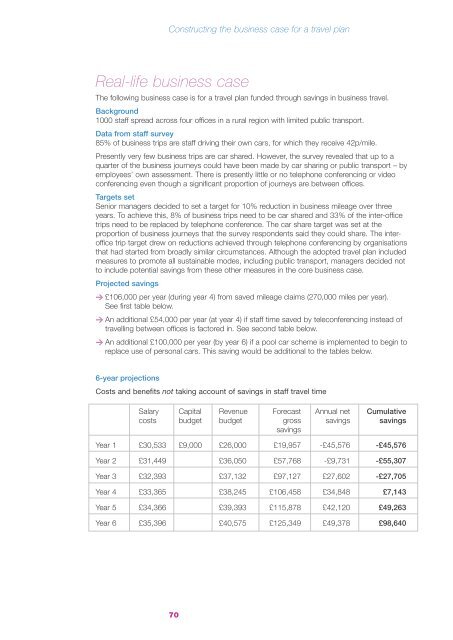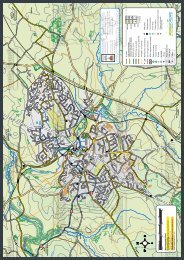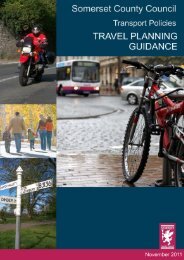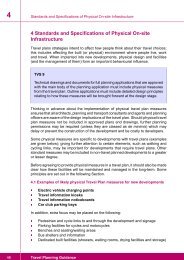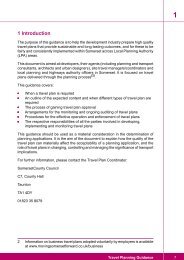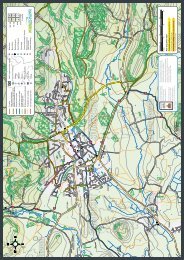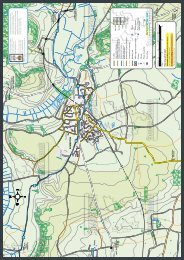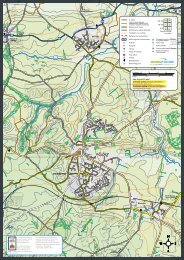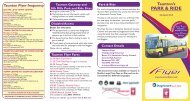Constructing the business case for a travel plan - Moving Somerset ...
Constructing the business case for a travel plan - Moving Somerset ...
Constructing the business case for a travel plan - Moving Somerset ...
Create successful ePaper yourself
Turn your PDF publications into a flip-book with our unique Google optimized e-Paper software.
<strong>Constructing</strong> <strong>the</strong> <strong>business</strong> <strong>case</strong> <strong>for</strong> a <strong>travel</strong> <strong>plan</strong><br />
Real-life <strong>business</strong> <strong>case</strong><br />
The following <strong>business</strong> <strong>case</strong> is <strong>for</strong> a <strong>travel</strong> <strong>plan</strong> funded through savings in <strong>business</strong> <strong>travel</strong>.<br />
Background<br />
1000 staff spread across four offices in a rural region with limited public transport.<br />
Data from staff survey<br />
85% of <strong>business</strong> trips are staff driving <strong>the</strong>ir own cars, <strong>for</strong> which <strong>the</strong>y receive 42p/mile.<br />
Presently very few <strong>business</strong> trips are car shared. However, <strong>the</strong> survey revealed that up to a<br />
quarter of <strong>the</strong> <strong>business</strong> journeys could have been made by car sharing or public transport – by<br />
employees’ own assessment. There is presently little or no telephone conferencing or video<br />
conferencing even though a significant proportion of journeys are between offices.<br />
Targets set<br />
Senior managers decided to set a target <strong>for</strong> 10% reduction in <strong>business</strong> mileage over three<br />
years. To achieve this, 8% of <strong>business</strong> trips need to be car shared and 33% of <strong>the</strong> inter-office<br />
trips need to be replaced by telephone conference. The car share target was set at <strong>the</strong><br />
proportion of <strong>business</strong> journeys that <strong>the</strong> survey respondents said <strong>the</strong>y could share. The interoffice<br />
trip target drew on reductions achieved through telephone conferencing by organisations<br />
that had started from broadly similar circumstances. Although <strong>the</strong> adopted <strong>travel</strong> <strong>plan</strong> included<br />
measures to promote all sustainable modes, including public transport, managers decided not<br />
to include potential savings from <strong>the</strong>se o<strong>the</strong>r measures in <strong>the</strong> core <strong>business</strong> <strong>case</strong>.<br />
Projected savings<br />
> £106,000 per year (during year 4) from saved mileage claims (270,000 miles per year).<br />
See first table below.<br />
> An additional £54,000 per year (at year 4) if staff time saved by teleconferencing instead of<br />
<strong>travel</strong>ling between offices is factored in. See second table below.<br />
> An additional £100,000 per year (by year 6) if a pool car scheme is implemented to begin to<br />
replace use of personal cars. This saving would be additional to <strong>the</strong> tables below.<br />
6-year projections<br />
Costs and benefits not taking account of savings in staff <strong>travel</strong> time<br />
Salary Capital Revenue Forecast Annual net Cumulative<br />
costs budget budget gross savings savings<br />
savings<br />
Year 1 £30,533 £9,000 £26,000 £19,957 -£45,576 -£45,576<br />
Year 2 £31,449 £36,050 £57,768 -£9,731 -£55,307<br />
Year 3 £32,393 £37,132 £97,127 £27,602 -£27,705<br />
Year 4 £33,365 £38,245 £106,458 £34,848 £7,143<br />
Year 5 £34,366 £39,393 £115,878 £42,120 £49,263<br />
Year 6 £35,396 £40,575 £125,349 £49,378 £98,640<br />
70


